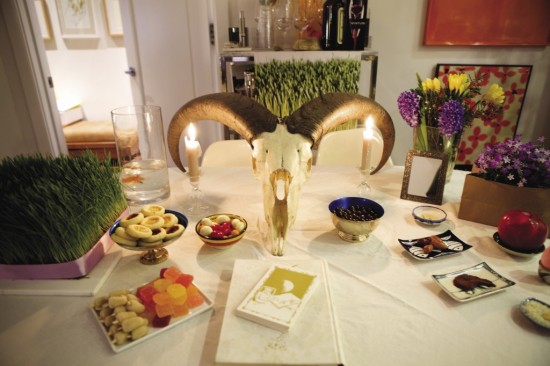As a girl, Nazli Parvizi knew it was nearly Nowruz when her mom would start baking like a madwoman.
This was in Worcester, Massachusetts—not Tehran—but even expat Iranians cook around the clock for Nowruz, the 3,000-year-old Persian New Year celebration that heralds the return of spring, transcends religion and incites people to simmer and stir for the family and friends who will soon come pouring through the door.
“The sweets start weeks in advance,” recalls Nazli, who could tell the holiday was drawing near when her childhood kitchen became redolent with rose water and chickpea flour. “My mom would make hundreds of each kind of cookie. That’s how you’d know.”
Today Parvizi is New York City’s Commissioner of Community Affairs (which at times demands 18-hour days) and says there’s not really an Iranian community in the city (for that, go to Great Neck). But she’s a killer cook and a proud board member of the tradition-espousing Slow Food USA, so each March she summons her skills as a former caterer, her background studying food anthropology at Columbia, and the flavors of her ancestors, turning her apartment high above the corner of Flatbush and Atlantic into a palatial house party that smells unmistakable to anyone who’s ever lived in Iran—and irresistible to anyone who hasn’t.
“It’s like Thanksgiving, Christmas and New Year’s rolled into one,” says Parvizi of the holiday, which is hands-down the biggest bash of the year in Iran, no matter your faith. (Some hosts greet guests with a holy book, but it might be the Bible, Torah or Koran.) Parvizi’s been throwing annual Nowruz fests in New York for over a decade, originally as “the 12 to 12 party”—a noon-to-midnight open house, from which guests stumbled home stuffed with saffron and pistachios.
Her favorite Nowruz dish? “All of em,” she laughs.
Fish and rice are non-negotiable—think Thanksgiving turkey and stuffing—but the sides are wide open, and she’ll prepare groaning platters of anything from pomegranate-perfumed chicken to Turkish-stuffed cabbage with saffron-vinegar glaze.
She hits Sahadi’s for pomegranate paste and basmati, but rarer ingredients like barberry are smuggled back from Iran in suitcases. “At least now you can get slivered almonds,” she laughs. “My mom used to sit there and slice each one!”
Other ingredients have locavore cred, like Greenmarket-sourced black sea bass (roasted with lime) or upstate carrots (home-candied and strewn atop that requisite rice). But the dish that most sings of spring is the fresh herb plate on every Iranian table: tarragon, mint, watercress, cilantro, dill and scallions. Don’t confuse them with parsley-sprig wallflowers, says Parvizi. “People grab ’em and eat by the handful.”
While tradition calls for a surplus of sweets, Parvizi demurs. “I’m the worst because I hate Iranian desserts,” she admits, instead offering sophisticated riffs on her homeland’s flavors, such as Earl Grey panna cotta and saffron ice cream.
The room always includes a few “random” expats she’s met over the years—for them, she says, eating alone on March 21 would be like exiled Americans skipping Thanksgiving—but most guests are new to Nowruz, and Parvizi is proud to play ambassador.
“It’s possibly my only link to my country,” she says. “It’s the only sort of ritualistic thing that marks me distinctly as Iranian.”
Back in Iran, Nowruz brings two weeks of goodwill. “It’s, like, the one time there’s a truce in Iran,” says Parvizi. “It’s a time of renewal and peace. It means good things for the country.”
Americans might not equate Iran with peace, but at Nazli’s Nowruz, everyone’s in sync with that celebratory spirit. “It’s an opportunity to teach others about our history,” she says. “I have so many friends who know this holiday and now enjoy it. Plus I get to cook and they get to eat for 12 hours. I think that’s pretty great.”
Photo credit: Clay Williams







